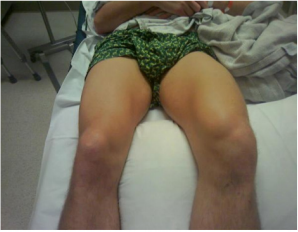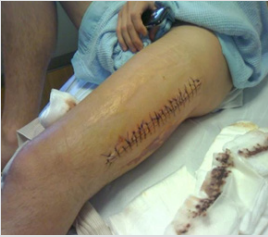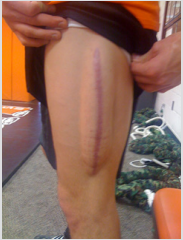Case Report
A NCAA Division 1 wrestler was struck on his anterior left thigh by the knee of another wrestler during practice. Although he felt severe pain, he continued to practice after which he applied ice to the thigh. Feeling a bit better, he went to a football game. By halftime, though, he noticed the pain and swelling worsened, and he could not sit down. He then left the game and called the team physician who accompanied him to the local hospital ER for further evaluation. On arrival at the ER he was in moderate to severe distress due to thigh pain. His vital signs included a temperature of 97.3F, a pulse of 71, respirations of 18, blood pressure of 148/86 and a pulse oximetry of 100%. He had significant swelling and tenderness to his left anterior thigh. Further he is noted to have decreased strength to his left lower extremity but sensation was intact. The differential diagnoses were
a) Quadriceps Contusion,
b) Quadriceps tear,
c) Compartment Syndrome.
Notable laboratory studies included total creatine kinase of 1023 (normal 57-374), white blood cell count of 13.3 (normal 4.5- 10.8), hemoglobin of 13.0 (normal 14.0 18.0), and serum creatine of 1.0 (normal 0.5-1.5)A working diagnosis of a traumatic anterior thigh compartment syndrome was made. The on-call orthopedic surgeon concluded that because of the clear signs and symptoms of a traumatic quadriceps compartment syndrome, imaging and pressure readings were not considered necessary and the patient was taken to the operating room for a lateral thigh decompression fasciotomy (Figure 1). This procedure was followed on subsequent days with irrigation and debridement and skin closure. Following a 6 week rehabilitation period, the athlete returned to wrestling practice without sequellae.
Discussion
Compartment syndrome of the thigh is rare, but the high morbidity and mortality make it important to remember when seeing blunt trauma from a motor vehicle accident, thigh contusion, femur fracture or the use of military anti-shock trousers. It requires a large volume of blood to cause a pathologic increase in interstitial pressure (Figures 2 & 3). This is due to the large size of the thigh and due to the fascial compartments of the thigh blending anatomically with the muscles of the hip (potentially allowing extravasation of blood outside of the compartment) [1-3].
Literature Review
A Medline Ovid and Pub Med search found no documented cases of thigh compartment syndrome in wrestlers.
References
- Mithofer K, Lhowe DW, Altman GT (2002) Delayed presentation of acute compartment syndrome after contusion of the thigh. Journal of Orthopedic Trauma 16(6): 436-438.
- Rooser B, Bengtson S, Hagglund G (1991) Acute compartment syndrome from anterior thigh muscle contusion: a report of eight cases. Journal of Orthopedic Trauma 5(1): 57-59.
- Schwartz JJ, Brumback RJ, Lakatos R, Poka A, Bathon H, et al. (1989) Acute compartment syndrome of the thigh. The Journal of Bone and Joint Surgery 71: 392-400.

 Case Report
Case Report


